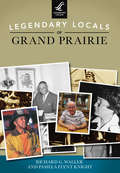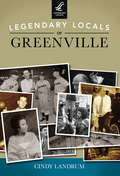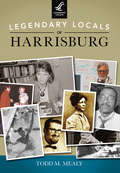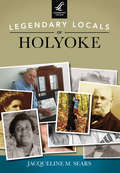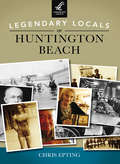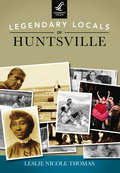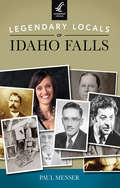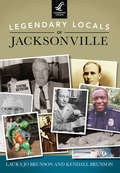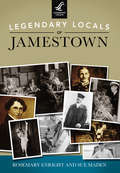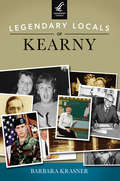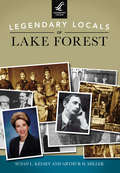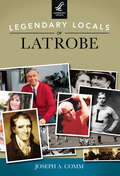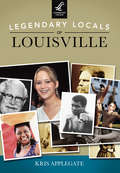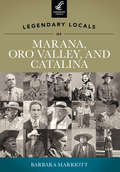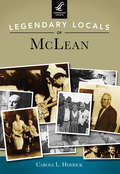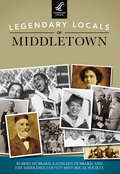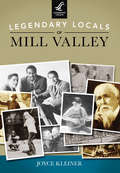- Table View
- List View
Legendary Locals of Gallup (Legendary Locals)
by Bob Rosebrough Carol Sarath Elizabeth Hardin-BurrolaGeography has conspired to make Gallup, New Mexico, a special place with unique people and a colorful history. It has been a place of struggle and extremes where cultures have clashed, mixed, and melded. Gallup is a community that is simultaneously challenging and uplifting, heartrending, and redemptive. To local Native Americans, the Navajo and Pueblo people, Gallup is located on their ancestral homeland and bordered by their sacred sites. To early settlers, Gallup was a place that permitted transportation across the continent, first by foot and horseback, then by stagecoach and railroad, and ultimately, by America’s Mother Road, Route 66. With its founding, Gallup became a place where European, Asian, and Hispanic immigrants—with hands that built America—came to construct a transcontinental rail line, harvest timber, mine coal, and establish businesses, while seeking a new life among the region’s original native people.
Legendary Locals of Grand Prairie
by Pamela Flynt Knight Richard G. WallerGrand Prairie is a city on the edge. Citizens have been innovators with a love for family and community. Alexander Dechmann traded land to insure a railroad depot; early settlers started schools for their families; and the police department hired one of the first women. Leaders at nonprofits such as Brighter Tomorrows not only helped the local community, but also helped develop services in surrounding communities. Business owners and volunteers have strong family traditions of giving back to Grand Prairie, and civil servants have loyalties for extended years of service, such as Ruthe Jackson and her family, who provided support for both businesses and the community. From the early settlers to today's city, Grand Prairie is built upon loyalty.
Legendary Locals of Greene County
by Wanda Dorpfeld David DorpfeldGreene County was created in 1800 from parts of Albany and Ulster Counties, and it is named after Gen. Nathanael Greene of Revolutionary War fame. Early on, the economy of the county was primarily agricultural with a few small mills and most of the settlements located along the Hudson River and its tributaries. In the early 19th century, the economy took off: people from New England began settling the mountains to the west, the Susquehanna Turnpike opened, leather tanning and brick- and pottery-making became prominent, ice was harvested and shipped to New York City, ship-building gained importance, and tourism started to be popular. Today, tourism is still important to the area, and the county features two major ski resorts. Much of Greene County is also part of the Catskill Mountain Park, which attracts many nature-lovers all year round. Over the years, county natives and transplants have made many contributions to industry, entertainment, government, military, recreation, and the arts.
Legendary Locals of Greenville
by Cindy LandrumGreenville has long been a city of visionaries. Richard Pearis settled on the banks of the Reedy River in Cherokee hunting land where few white men would venture. Max Heller, who escaped Nazi-occupied Austria as a teen, triggered the rebirth of downtown. They are some of Greenville's local legends who have seen possibilities, not limitations. They come from all walks of life. Textile leaders such as John T. Woodside, Thomas Parker, and John D. Hollingsworth transformed the city into the "Textile Capital of the World." When textiles began to fade, businessmen and leaders such as Charles Daniel, Tommy Wyche, Tom Barton, Virginia Uldrick, Dick Riley, Carl Sobocinski, and Xanthene Norris helped transform the city once again. Stories of people who have shaped Greenville with their vision, making it what it is today, fill these pages.
Legendary Locals of Harrisburg (Legendary Locals)
by Todd M. MealyWith images taken from the archives of the Dauphin County Historical Society, as well as family collections, Legendary Locals of Harrisburg encompasses biographical tributes that celebrate the deeds of actors, musicians, artists, teachers, athletes, humanitarians, politicians, veterans, firemen, and community leaders who have added a peculiar brand of Harrisburg's rich cultural tapestry. William Howard Day, an educator, and John Harris, who established Harrisburg, are two pioneers. Edward Stackpole, of Stackpole Books, and Theophilus Fenn, editor of the Telegraph, have forged the way for the city's writers. The first secretary of homeland security, Tom Ridge, and Simon Cameron, secretary of war under Lincoln, are among world-renowned politicians who have contributed to Harrisburg's valued reputation. From rival high school football coaches to dueling business owners, from civic leaders building an integrated city to aspiring young people embarking on independent journeys to the big screen, these profiles of real lives and real heroes show us that we all have contributed to the development of our own communities.
Legendary Locals of Holyoke
by Jacqueline M. SearsHolyoke is home to some of the most amazing and courageous individuals. In 1658, European pioneer John Riley, along with other early planters, was instrumental in establishing a community in the West Springfield area called Ireland Parish, which eventually became known as Holyoke. This tenacious man led the way for many other trailblazers, including George Ewing, who envisioned utilizing hydropower to operate factories and inspired town engineers to design one of the first planned cities in the United States. In 1898, the progressive Elizabeth Towne encouraged Holyoke residents and an international audience with her New Thought movement that advocated a healthy lifestyle. Another outstanding citizen, Timothy Alben, judiciously leads the Massachusetts State Police, while Holyoke's Henry Jennings honorably served his country in the armed forces, as a commander of the Holyoke War Memorial Building, and on the Holyoke City Council. Barbara Bernard has astutely kept residents informed about current events for the last 70 years. Legendary Locals of Holyoke chronicles the community's finest men and women who survived and prospered through harsh circumstances and against all odds.
Legendary Locals of Huntington Beach
by Chris EptingFor over 100 years, Huntington Beach, a.k.a. "Surf City, USA," has come to represent the true beach culture of Southern California. Originally called Pacific City, it was when railroad magnate Henry Huntington first ran his train line down in 1904 from Los Angeles, approximately 40 miles north, that the then-quaint beach town took on the name that made it famous around the state and around the world. In 1914, the legendary George Freeth put on a surfing exhibition the day the city's vaunted concrete pier was opened, which christened Huntington Beach as a soon-to-be surfing mecca. It became a boomtown after oil was discovered in 1920 and, several decades later, morphed once again into a cradle of aerospace engineering when companies such as Boeing arrived. Throughout its tumultuous and dramatic history, Huntington Beach has always boasted a cast of colorful and profound characters. From the first mayor, Ed Manning, to Medal of Honor-recipient Chris Carr, from the Zamboni family (who invented the ice-cleaning machine) to baseball star Jeff Kent: the list is almost endless. But it is not just professional athletes, actors, and rock stars; it is the teachers, crossing guards, merchants, and activists that give Huntington Beach its well-earned reputation as one of the most interesting and charismatic cities in the state.
Legendary Locals of Huntsville (Legendary Locals)
by Leslie Nicole ThomasFirst they came for the land, later they came for the stars and the moon; all found themselves against the glorious backdrop of the Tennessee Valley. Legendary Locals of Huntsville chronicles the story of Rocket City, a sleepy, Southern cotton town that weathered the Great Depression with its mill villages, gained national attention with Redstone Arsenal, blossomed into the center of aerospace development, and became the home of the largest arts center in the Southeast. Notables include pioneer John Hunt and founding father LeRoy Pope; aerospace engineer Wernher von Braun; world-renowned portrait artist and poet Howard Weeden and cobweb artist Anne Clopton; internationally known soprano Susanna Phillips; Professional Football Hall of Fame member John Stallworth; performing arts pioneers Helen Herriott and Loyd Tygett; and entrepreneur and philanthropist Mark C. Smith. The stories herein celebrate just a handful of the many people who have made a memorable impact on this community and who continue to propel Huntsville forward through leadership by example.
Legendary Locals of Idaho Falls
by Paul MenserIn 1864, a stage line driver named Matt Taylor and two associates decided Black Rock Canyon was the place for a toll bridge to handle traffic to and from Montana. The following year, their bridge opened and a town called Eagle Rock took shape. With the coming of the railroad, trains brought everyone from saloon keeper Dick Chamberlain to temperance crusader Rebecca Mitchell. To project a more genteel air, Eagle Rock became Idaho Falls in 1891. Joseph Clark, the first mayor, and newspaper publisher William Wheeler were just two of the people who helped pave the streets and turn on the lights. After assiduous wooing by boosters such as Bill Holden, D.V. Groberg, and E.F. McDermott, the Atomic Energy Commission in 1949 chose Idaho Falls for the headquarters of its National Reactor Testing Station. Today, Idaho Falls is a vital trading and service center with two hospitals, a professional baseball team, symphony orchestra, and world-class museum. It is also the hometown of some remarkable people who have gone out in the world to make names for themselves.
Legendary Locals of Intown Atlanta (Legendary Locals)
by Janice McDonaldWhen Hardy Ivy built his small cabin on a ridge in the North Georgia wilderness in 1833, no one could have imagined his property would grow to become the internationally recognized city Atlanta is today. Ivy is just one of those whose impact on Atlanta has earned him the right to be called a legendary local. This book includes those with international acclaim like Cable News Network founder and environmentalist Ted Turner, civil rights leader Dr. Martin Luther King, Jr., and former president Jimmy Carter. No less important, but lesser known, are former slave Carrie Steel Logan, who started the first orphanage for black children in Georgia, and May Belle Mitchell, the mother of Gone With the Wind author Margaret Mitchell. May Belle was a legend in her own right for leading the Atlanta women�s Equal Suffrage League in the early 1900s. These stories span centuries, highlighting only some of the true legendary locals of Intown Atlanta.
Legendary Locals of Jacksonville (Legendary Locals)
by Kendall Brunson Laura Jo BrunsonSince Europeans first settled along Jacksonville's riverbanks in the 16th century, the area has been a diverse community that thrives not only on commerce, music, and the arts but also on the advantages of a subtropical climate and waterside lifestyle. The city grew up around a crossing point for cattle in the St. Johns River and first became known as Cowford. The Great Fire of 1901 left 10,000 people homeless but not defeated. The ashes gave birth to a new era with strong architecture and a new resolve. Considered a friendly town for African Americans, Jacksonville was home to Harlem Renaissance artists as well as civil rights leaders. A bit laid back, the city has still managed to be on the cutting edge--it was the home of the Navy's Blue Angels as well as Southern rock and one of the country's first skateboard parks.
Legendary Locals of Jamestown
by Sue Maden Rosemary EnrightWhen Caleb Carr, one of the 101 men who purchased Conanicut and Dutch Islands in 1657, petitioned the General Assembly to incorporate Jamestown in 1678, the town had 150 inhabitants. The community thrived until the American Revolution, when the British occupation drove away many people. Nicholas Carr and John Eldred both remained, rebelling in their own ways. The town recovered slowly, and its character changed with modernized modes of transportation. Steam ferries, introduced in 1873, ushered in an era of resort hotels, affluent summer visitors, and a service economy. The West Passage bridge in 1940 brought permanent residents with off-island occupations and interests. The East Passage bridge (1969) and the replacement West Passage bridge (1992) created a suburban atmosphere enlivened by a continuing influx of summer vacationers. Most newcomers revel in the island's beauty and are intent on keeping Jamestown the peaceful haven that attracted them.
Legendary Locals of Kearny
by Barbara KrasnerHeroes lead, inspire, and perform memorable acts that shape the lives of others. In the pages of this book, readers will learn the stories behind Kearny's heroes--the people whose contributions made Kearny into the thriving, diverse community it is today. Ed Karolasz gave his life for his country during the war in Iraq. Councilman Norman Doyle helped a young girl get the medical attention she needed. College student Gabriela Salvador restores historic costumes for the town museum. Real estate developers Louis Lindblom and Edward Strong built the town's financial institutions and the Arlington section. Educators Peg Bixler and Barbara Toczko devoted themselves to their students. From the town known as Soccertown, USA, came John Harkes, Tony Meola, and Tab Ramos, who played on the United States team in the FIFA World Cup. But there was also Louis Eilshemius, the somewhat mad and reclusive artist, and Albert Gonzalez, a government informant and computer criminal. This "City of Opportunity" has produced more than its share of personalities that have created admirable and notorious international, national, and local legends.
Legendary Locals of Kent County
by Patricia Joan HorseyKent County, located on the Eastern Shore of the Chesapeake Bay, is noted for its farms, outdoor recreation, architecture, and its people. Legendary Locals of Kent County recognizes only a handful of the many Kent County people who deserve to be noted. Included are Tony Award-winning Mark Bramble, who is a director, author, and producer; controversial and colorful Evelyn Harris, also known as the "Barter Lady," who gained fame during the Depression when she proposed a system of swapping to overcome the shortage of money; elected official, school principal, minister, and artist Clarence Hawkins; Sheriff Bartus O. Vickers, who earned the respect of prisoners, lawyers, other law enforcement officers, and citizens; game warden Bozy Robinson, friend of both the hunter and the hunted; and writer Gilbert Byron, who detailed life on the Chesapeake Bay throughout the 20th century.
Legendary Locals of Lake Forest (Legendary Locals)
by Arthur H. Miller Susan L. KelseySince the 1850s, Lake Forest, located 30 miles north of Chicago on Lake Michigan, has been a distinctive suburb. It has been a retreat from the diseases, public accessibility, rougher elements, soot, stockyard smells, and general density of bustling city life. For at least five generations, it has been the retreat for Chicago's leading New England-descended families, such as the Farwells, Swifts, and Armours. And for over 150 years, Lake Forest has been the home for a community of educators, merchants, artisans, designers, and a wide variety of estate specialists, the latter from pre-Civil War escaped slaves and Scots and Irish immigrants to today's notable garden and interior artists. Legendary Locals of Lake Forest draws on rare archival images from local and Chicago public and private sources.
Legendary Locals of Lake Worth (Legendary Locals)
by Lawana Mauldin Joe McdanielDuring the early 1900s, a large reservoir built to provide water for Fort Worth, Texas, also opened up opportunities for businesses to develop. Casino Beach, Casino Ballroom, and a large bathhouse became popular spots for thousands. A nearby village, with increasing population, soon had a small school, churches, and other establishments. With nearby Jacksboro Highway running from downtown Fort Worth past the beach area, gambling increased, as did gangster activity. After a long while, with much intervention, these unlawful situations became history. Legendary Locals of Lake Worth spotlights the founders of the small village and features individuals who impacted the area--many for the better, others for the worst. Some may never have received proper recognition until this book's acknowledgment of them.
Legendary Locals of Lakewood (Legendary Locals)
by Walter Neary Steve DunkelbergerLakewood was a vibrant community long before it incorporated in 1996, though cityhood helped give the area one name and identity. In the mid-19th century, Lakewood was the site of British farms and the first US military base in Washington Territory. Men who became famous in the Civil War, such as George Pickett, served there. Native American leader Leschi, the victim of "judicial lynching" by civilians, spent his last days there. As Lakewood became a retreat for Puget Sound's rich and famous, names such as Carman and Alexander--as famous in their day as the name Weyerhaeuser was and is--settled here, leaving behind reminders like Lakewold Gardens. One of Lakewood's most famous residents was Ivan, a captive gorilla who captured the hearts of animal lovers worldwide.
Legendary Locals of Las Cruces
by Charlotte TallmanWhen Las Cruces was founded 164 years ago near a group of crosses marking the graves of travelers and soldiers, a rawhide rope separated acreage for a church, a cemetery, and family lots. That rawhide rope brought to Las Cruces a new era filled with the exhilaration of the Wild West and the people who molded "the City of the Crosses." Over the decades, the number of local men, women, and children who deserve recognition as heroes of history or champions of the present is infinite, including Dr. Nathan E. Boyd, entrepreneurial creator of the Boyd Sanitarium; Gov. Susana Martinez, the first female governor of New Mexico and the first female Hispanic governor in the United States; and Letticia Martinez, a legally blind swimmer who competed with the 2012 London Paralympics Swimming Team. Like thousands of others, theirs is a story of persistent hope, courage, and desire to make a difference.
Legendary Locals of Latrobe
by Joseph A. CommLocated at the base of the rolling hills of the Laurel Highlands, Latrobe is best known as the birthplace of children's television pioneer Fred Rogers and golf legend Arnold Palmer. It is the home of Rolling Rock Beer, Pittsburgh Steelers training camp, and St. Vincent College. Latrobe has also been recognized for many famous firsts, like the first banana split, first all-professional football team, first Benedictine monastery in the United States, first nonstop airmail pickup, and first female nuclear scientist at Westinghouse Electric Company. It is a community of individuals who collectively exemplify the strong, hardworking culture of Western Pennsylvania--people like Oliver Barnes, a railroad engineer and Latrobe's founder; Philip Mowry McKenna, innovator in the machining of steel and father of "Kennametal" tools; Joseph E. Greubel, who transformed his family's ice cream-centered dairy stores into the thriving Valley Dairy Restaurants; Dr. Sara Carr McComb, a "legendary" librarian; and Robert Mendler, a Holocaust survivor who spent his life educating young people to respect one other. Legendary Locals of Latrobe celebrates these and nearly 200 other noteworthy figures and groups who have shaped and continue to shape the community.
Legendary Locals of Los Gatos
by Stephanie Ross Mathews Peggy Conaway BergtoldIn 1878, Charles Erskine Scott Wood, builder of the Cats Estate, wrote "Good citizens are the riches of a city." From its beginning, Los Gatos has suffered no shortage of hardworking, inventive, entrepreneurial, and gifted people. Early orchardists found the land unbelievably productive, but their crops were threatened with disease and pesky infestations of gophers. John Bean and Zephyr Macabee provided solutions. Louise Van Meter was an unconventional teacher who championed the new concept of kindergarten. Neta Snook Southern defied traditional female roles to become a pilot. She taught Amelia Earhart to fly before retiring to Los Gatos, where she raised prunes, apricots, and miniature horses. John Steinbeck wrote The Grapes of Wrath during one long, hot summer in town. Steve Wozniak settled in Los Gatos and donated computers to schools. The lives presented here have contributed to the sparkling legacy of the "Gem City of the Foothills."
Legendary Locals of Louisville
by Kris ApplegateDespite humble beginnings on Corn Island in 1778, the city of Louisville has grown to legendary status. Courageous individuals have worked together overcoming hardships, defeating enemies, celebrating victories, and laying the foundation for our river city. Louisville is the home of many legends including boxing great Muhammad Ali, William Clark (of the famed Lewis and Clark Expedition), baseball star Pee Wee Reece, Academy Award-winner Jennifer Lawrence, Pulitzer Prize-winner Marsha Norman, broadcast journalist Diane Sawyer, sculptor Ed Hamilton, and author Hunter S. Thompson. Other legends who have called Louisville home include Kentucky Fried Chicken founder Colonel Harland Sanders, actor Tom Cruise, and inventor Thomas Edison. Louisville boasts the nation's largest annual fireworks display, the world's largest baseball bat, and "The Most Exciting Two Minutes in Sports" also known as the Kentucky Derby. You are invited to read about these and more exceptional folks who have shaped our eclectic city called Louisville.
Legendary Locals of Marana, Oro Valley, and Catalina
by Barbara MarriottRunning west to east along the northern boundary of Tucson is a corridor. of unique and inspiring communities. In Legendary Locals of Marana, Oro Valley, and Catalina, readers will discover the historical riches, courage, and determination of the Western spirit that shaped the state and the country. George Pusch was a member of the Arizona Territorial Legislature that guided Arizona from territory to statehood. Sam Chu, a Chinese immigrant, turned barren land into one of the most productive cotton farms in America. Sheriff John Nelson helped establish Arizona's reputation as cattle country. Under the guidance of Dick Eggerding, the public arts program made Oro Valley one of the best small towns in America. America's talented athletes have called the corridor home, including Hank Leiber, 1930s baseball star; Maren Seidler, Olympic shot-putter; and Sherry Cervi, barrel racing champion. In these communities, charity work, artistic talent, and military courage are found in abundance. If people make history, then the corridor is a treasure trove of the country's past and future.
Legendary Locals of McLean
by Carole L. HerrickMcLean, Virginia, a whistle stop along the Great Falls & Old Dominion Railroad, came about in 1910. It was named after John R. McLean, publisher of the Washington Post newspaper and an owner of the railroad. This was a farming community that never incorporated. A few of the families instrumental in the formation of the village that followed were Mackall, Laughlin, Storm, Carper, and Smoot. Because of its proximity to the nation's capital, McLean attracted people from all walks of life. But it was the arrival of the Kennedy families in the late 1950s that put McLean on the map. The thread that holds the community together is spirited volunteerism. This volume contains images of a few of the personalities who give McLean a sense of place. The majority of the photographs have been donated by individuals to ensure that history does not lose these significant personalities, past or present, who left an imprint on their community.
Legendary Locals of Middletown
by Kathleen Hubbard Robert Hubbard Middlesex County Historical SocietyAlthough the town benefits from a position on a major navigable waterway, Middletown's success is primarily due to the energy, creativity, and diversity of its people. These include James Riley, whose autobiography detailing his trials as a white slave in Northern Africa showed millions of Americans the evils of slavery; Max Corvo, who helped the World War II Italian underground defeat the fascist regime; and Christie Ellen McLeod, longtime chief pathologist at Middlesex Memorial Hospital. Middletown can boast of athletes such as Helen "Babe" Carlson, a tremendously strong competitor who participated on men's baseball teams; Willie Pep, who, while going for the world featherweight title, had a record of 134 wins and only one loss; and Corny Thompson, who sparked the University of Connecticut basketball program's rise to national prominence. More notables include Allie Wrubel, a prolific songwriter and Academy Award winner for his song "Zip-A-Dee-Doo-Dah;" Vivian McRae Wesley, a teacher, reading director, and leader of Middletown's African American community; and Francesco Lentini, who was born with three legs and appeared in every major circus and carnival.
Legendary Locals of Mill Valley
by Joyce KleinerSince the 1800s, Mill Valley has attracted spirited freethinkers, entrepreneurs, nature lovers, rabble-rousers, and more than a few rock stars. Early Mill Valley booster Sidney Cushing encouraged tourism with a train up Mount Tamalpais called "the Crookedest Railroad in the World." Laura White, more concerned with protecting Mill Valley's natural beauty than attracting more people, brought the town its "Outdoor Art Club" and a tradition of conservationism. Vera Schultz broke the glass ceiling of local politics in 1946, and in 1973, 10-year-old Jenny Fulle's letter to President Nixon changed the future of America's female athletes. When an elementary school teacher named Rita Abrams wrote a song about why she loved Mill Valley, it became a national hit; so did a song about the heart of rock and roll, written by local boy Huey Lewis, who had attended that same school. The stories of Mill Valley's legendary locals--whether from 1890 or 1980--are sometimes heartbreaking, sometimes inspiring, often humorous, and always fascinating.

